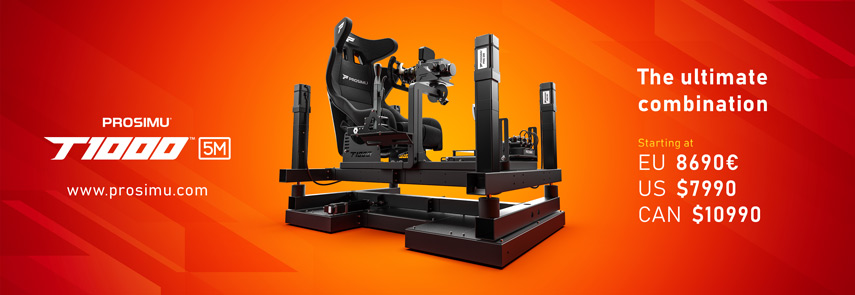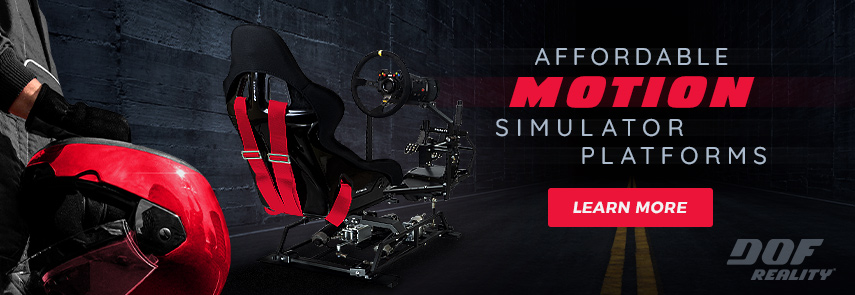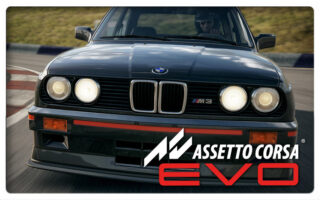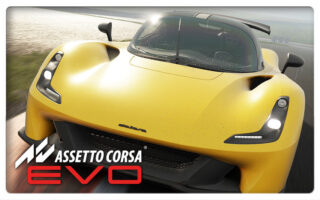GAME vs REALITY: Driver’s Eyes Comparison In Mazda MX-5
Polish racing driver and Simrace.pl member Damian Lempart, wrote a very interesting article supporting the sim-racing to real racing transition. Damian took his Mazda MX-5 NA to a Poznań Track Day in order to make a detailed comparison between the real and virtual car as available in the Assetto Corsa racing simulator. Damian tries to find out if his driving techniques and the car handling properties in both the real and virtual version match up.
A big thanks to Damian Lempart, Rauf Zero, Tommi, and K.A.R.R, for allowing me to reproduce this very informative article on the Bsimracing platform.
Game vs Reality by Damian Lempart
With a development of technology and available hardware and software, some trends are changing. These changes appear all the time in our daily, standard and professional life. We are eating other food, we work out differently at the gym or we are working or learning with new, available technology. Everything is not only for better results in different fields of life, but also to exceed human limits constantly. However, we should remember that a lot of new methods still are based on earlier experience and knowledge. Anyway, driving a car is based on physical laws from many years ago. Only technology is undergoing changes, but the whole physics is the same for everyone and everything in this world.
In case of the sports car driving, the preparations are changing constantly. Until the 80’s drivers could base only on low-quality on-boards, the experience of their team and engineers, their own knowledge and intuition. Only later, the first basic data logging systems were developed, which were the progenitors of the modern systems, equipped with hundreds of sensors to measure almost everything which is possible and important about racing. These sensors collect data with a size of about 30MB per one lap and after the whole racing weekend, every team has got terabytes of data. Every plot is analyzed precisely. Terabytes of collected data allowed later to develop racing simulators. Teams have worked a lot to develop their rigs, which are worth even over a dozen million dollars, with directly implemented elements, from the real cockpit to give their drivers the best possible preparation. A whole team has got a possibility to prepare for the racing weekend in every possible part.
Over the time, these trends touched the ordinary people. Most people have access to a PC or the Internet, which allows using software (or their substitute) and what is more – this is almost the same software as used by pros. Everything can be used for fun or to learn, but everyone can use it to correct their results or driving technique. In this article, I want to show you the comparison of my Mazda MX-5 NA with almost the same virtual car, which is available in Assetto Corsa.
The Mazda MX-5 is a car, which I do not have to present to the “petrolheads” or people who are interested in cars. Thanks to their handling properties, low weight, great 50:50 balance, this model could be very, very competitive versus even 3x more powerful cars with the use of proper tires. I could not hide my happiness when the developers of Assetto Corsa decided to implement this car to their simulator. Because of my addiction to cars and motorsport, as an active racing driver, sports driving instructor, vehicle mechatronics student and just “petrolhead”, I have decided to prepare an article, where I compare my own MX-5 with the one which is available in Assetto Corsa. This article could not be realized without the support of the “Tor Poznań Track Day” and “Carrera Cars Team” crew, who allowed me to participate in the best racing contest for amateurs and pros simultaneously. In my opinion, FIBARO Tor Poznań Track Day is a perfect opportunity to test my MX-5 within the framework of this article.
The next, important feature about choosing Tor Poznań to realize this test was the availability of the laser-scanned version of this track. The virtual circuit is based on the real data, with the accuracy of 1 cm. You can believe me or not, but personally, I cannot find anything to complain about the virtual version of this track, which is not worse than the original content (also laser-scanned). If you are not still sure, I can say that the virtual version of Tor Poznań is one of the most downloaded and popular “mods” and the reason is not that it is free. The main reason is that this circuit is perfectly modeled, which is very important not only for virtual training but also for the reliability of this article.
Why do I make this comparison with Assetto Corsa? I invite you to read my previous text, where I describe in detail why I use this simulator
PlayStation generation on the race track? Why not!
First, I would like to mention some differences between the two cars, e.g. the ones caused by the two different engines (my own 1.6 B6ZE(RS) 115HP vs 1.8 BP 130HP), lift versions, transmissions (still caused by different engines), suspension and tires, which are used in both cars. We can agree that in both cars there are stock setups. Except for the above-mentioned springs and tires, the rest is almost the same. The range of wheel alignment is “standard” – same as the data from manufacturer’s manual.
The tire pressures were also “standard” in the range about 1.8 bar / ~26 psi on cold tires – the same as it is recommended by the manufacturer. I think it is a good tire pressure range. As far as the aerodynamics is concerned – in reality, I drove with the soft top up because of the track day’s regulations (safety first, I do not have a rollbar) and the virtual model is without a top (soft or hard). The real drag coefficients are 0.38 with the top up and 0.40 with the top down, so it is not a huge difference. Personally, I did not feel any huge predominance in real life, comparing to the virtual car. In spite of these differences, I think it is still a trusty comparison, because the main construction of these cars is the same, and Assetto Corsa simulates “vehicle dynamics” in a very good way.
How does MX-5 handle?
Mazda MX-5 is an incredibly stable car, which is very easy to master during fast driving. Despite the rear-wheel drive, it is not rare to have understeer more than oversteer. I do not hide that it is difficult to precipitate this car from balance. When I sat behind the wheel of my MX-5 for the first time, I was sure that there was not another car in the world in this class and for this money, which handles like MX-5.
How then does her virtual counterpart handle? The biggest difference consists in more powerful BP engine, stock suspension springs and limited slip differential (which is called “LSD”). You can observe and feel how the transmission in Assetto Corsa “rectifies” the car, thanks to the presence of “LSD”. Most of the real cars are equipped with an open differential, just like mine. Despite that, slight horsepower in the amount of 115HP, very low weight of 930kg’s, low center of gravity and weight balance make the absence of “LSD” not be as painful as in other vehicles. From the first lap on Tor Poznań, I did not feel any lack of “LSD”. But there is a huge difference on the less-grip parts or on the slower corners.
Little off-topic, but still in connection with the topic – when I drove another MX-5 (Mazdaspeed NBFL, 1.8 Turbo), which was equipped with TorSen LSD, the similarity in behavior of the transmission and exits from the corners were very congruent to the vehicle dynamics of the car in Assetto Corsa. The huge difference was in the turbocharged engine and non-linear torque increase, which caused the nervous behavior of the car on the exits from slower circuit parts.
Frequent comparisons of Mazda to go-kart vehicle are not silly, but according to my opinion and experience from other vehicles – it is impossible to compare directly a car to the go-kart. There are huge differences in the construction of both vehicles. The main differences are that, on go-karts, the only “damping” parts are vehicles and there is stiff transmission without differential – and they are only a few of all-over differences between go-karts and cars.
Suspension and steering system
My MX-5 handles incredibly well in spite of its advanced years. Suspension and steering system in combination with proper sports tires and high-quality springs provide great grip on the corners, in almost every range of speed. Without any problem, you can feel every deformation of the surface where we are driving. In case of circuit driving, this set will provide a good handling precision.
The disadvantage of suspension is the car tilt – longitudinal and transversal. Engineers of Mazda have developed multi-wishbone suspension, which is a combination of driving comfort and sports performance. But for the typical circuit driving, all-over suspension parts are too soft. MX-5 have tendencies to tilts. Despite that, it is still difficult to provoke MX-5 and make it unstable, when a driver tries to drive smoothly. As a stock car, it also has tendencies for tilts during cornering, mostly because of their too soft anti-roll bars and the lack of a roof, which normally it provides extra stiffness for the whole car body.
The solution of the problem with the suspension disadvantages are for example stiffer, shorter springs and shock absorbers, and also thicker anti-roll bars. In case of rebuilding the car for motorsport usage, it is natural to mount full roll cage, which is not only for the driver’s safety but also to provide better car body stiffness.
As to the steering system – it is a standard system with power steering, without any innovations. The main feature is the short steering angle (900 degrees, same as in Assetto Corsa). The steering system works quickly and precisely, just like in the simulator. Some difference in the final effect could result from the usage of different tires and their features. The effect which results in the “lag” of the tire reaction on move of the steering wheel results in that in Assetto Corsa we can use only “road tire” model. In almost every road tires, the common effect during circuit racing is sidewall’s deflection, which results in the lag during cornering.
During cornering, just after a couple of seconds, the tires will work properly and as a result – the car will turn into the corner with a little delay. This is how the road tire works and this is modeled very precisely in the simulator. In the real car, I have semi-slick tires with stiff sidewalls and thanks to that – the delay in the tire work is less harmful. It is also important to take into account other elements, which can affect the driving precision, e.g. car body stiffness, suspension stiffness (e.g. damping adjustment or spring hardness, anti-roll bar stiffness and thickness, etc…)
About wheels geometry –The feeling from tire work was very similar. In the virtual car, such as in the real car, the negative tire camber was too small. It was possible to feel during cornering in the simulator and in real car, but in real life, you can check tire wear to judge if the camber is too small or too big
Braking system
The whole braking system is balanced and adjusted for a little understeer, but it is not difficult to use trail braking technique (braking in the middle of the corner). With the mix of good tires, the stock braking system works well. Despite the lack of ABS (in virtual and real case), brakes are very predictable. Only during hard braking, it is normal to lock the wheels a little bit, but the simple solution for this is to use a heel-and-toe technique or threshold braking.
Not only the direct braking points, but braking fields were incredibly similar, like the virtual ones. Why do I speak about “braking fields” and not about “points”? The fields about which I am writing were only slightly bigger areas than the direct points. In my opinion, the boundary of these fields was only approximately 2 meters from direct braking points from Assetto Corsa. I am writing about the definition of “field” because a lot of elements affect braking effectiveness, and the whole braking system is only one of them. It is important to take into account the other elements like tires, car setup, track conditions, weather, etc. For the whole day, I tried to brake almost in the same points, without any problems.
Engine/Transmission
For the engine and transmission performance comparison, I treat it with a pinch of salt, because my engine, despite the durability, has less horsepower and what is more – it has got some mileage, so there will be some signs of wear.
Since the first moment of driving on the track, I felt that I do not have as much horsepower as in virtual MX-5 (which is more powerful); the car accelerates worse and there are differences between gear ratios. In the places, wherein Assetto Corsa I had to shift up, in the real car, in real conditions it would be unprofitable – I could not accelerate as fast as it would be possible in the optimal way to achieve the best result.
The differences in the performance are so huge that there is not a lot to compare when the driver has to drive on the limit with both cars. The only thing which you can compare well is the characteristic of engine’s work or horsepower and torque range. Like in case of typical, naturally aspirated engine from Japan, we have to use high RPM range if we want to achieve the best engine’s performance. In the case of my Mazda, this range starts from 4500 RPM, and in virtual MX-5 from Assetto Corsa, this range started from 4000 RPM. The most profitable high RPM range limit in my real MX-5 was ended at approximately 6500 RPM, while the range for the version from the simulator was profitable even above 7000 RPM. Some differences can result not only from a less powerful engine, but also from engine wear, air temperature, and pressure. The behavior of both engines with whole transmissions was similar in respect of vehicle dynamics.
Conclusion
Mazda MX-5 is a car, which is very easy to handle – in the real life and in the simulator. The vehicle dynamics are very similar, despite the differences between my real car, which is equipped with sport springs, low-profile semi-slicks, and less powerful engine.
I am aware that for most people this element which I did not mention is important, but for me, it is only an extra. But no one can deny that it is quite relevant, especially when we compare the precision the workmanship of the virtual car, the track, and physics with the real ones. Of course, I have in mind the lap time. A long time before my arrival at the Track Day, I had assumed that if everything would be OK, I will get the lap time around 2:07 – with my knowledge about this track in real life, my car and its performance, my skills and that, what is modeled in the simulator.
Below I present my lap times, which I achieved in the real and virtual car.
- Reality: 2:06,866
- Assetto Corsa: 2:05,313
REALITY CHECK – Assetto Corsa vs real life | Mazda MX-5 Tor Poznań
The difference between lap times results from a lot of factors, which I described earlier or from other real factors and the ones which are modeled in a basic way. In my opinion, the most significant issue was the power gap, which combined with engine wear, equals more than 15HP and semi-slick tires, whose advantage is also a disadvantage at the same time; in case of weak cars – we have much bigger rolling drag and acceleration is more difficult. An important fact is that in circuit racing and mainly at Tor Poznań, every single horsepower unit counts.
I’ve had a possibility to test some other cars in real life, which are available in Assetto Corsa (e.g. Ford Mustang 5.0 V8 or Porsche 911 Turbo S [991.2]) and you can believe me or not – even taking into consideration some differences, about which I would have to write another paragraph, these cars handle and drives n a very similar way. I’ve decided to compare my MX-5 NA, despite the lack of the possibility to compare telemetry (old Miata doesn’t have OBDII / CAN line or sports ECU with the data logger), because this is my daily car, I think I know the dynamics and handling abilities of this car and what is more – It is much more available for ordinary people, and please remember that I am writing this article being a student
Finally, I want to say thanks to the whole “Tor Poznań Track Day” crew, for the possibility to participate in the great contest for drivers, “Simrace.pl” team with Rauf as a head admin – for the whole support in making articles like this one, and to Tomessi and K.A.R.R. for the help with making super realistic screenshots from Assetto Corsa , to my friend – Maciek Ławniczak, who has helped me with GoPro camera, Tommi and K.A.R.R. for the help with the screenshots from Assetto Corsa, and to my friend and photographer – Filip Flisek, who made a great photos from Tor Poznań Track Day.
I have to say thanks to all Tor Poznań Track Day competitors, who gave a confidence to my person, as an instructor and I’ve had a possibility to test their cars, which gave me a huge feedback and unique experience (especially that, while writing this text I am only 22 years old), but the materials for the text that you have just read. It is hard to mention each individual I have in mind and I do not want to omit anybody so that they will not feel hurt or unnoticed.
If you have enjoyed this text, feel free to comment it, express your own opinion or even to contact me via E-Mail or my Facebook. If you loved this text, I would be very grateful if you could share it with somebody who might be interested in this article.
Author: Damian Lempart
Text correction: Rauf Zero
Video: Rauf Zero/Simrace.pl
Photography: Filip Flisek sekPhotography
Ingame photos: Rauf Zero, Tommi, K.A.R.R.
Authors email: kontakt@damianlempart.pl
Facebook: facebook.com/lempartracing
Official Website: damianlempart.pl
Download link Tor Poznań:
Download
Sources:
www.assettocorsa.net
https://en.f1i.com/ma…-data-race.html
https://www.formula1-…/telemetry.html
https://miata.net/
 Bsimracing Sim Racing Resources and News for the racing enthousiast.
Bsimracing Sim Racing Resources and News for the racing enthousiast.
















